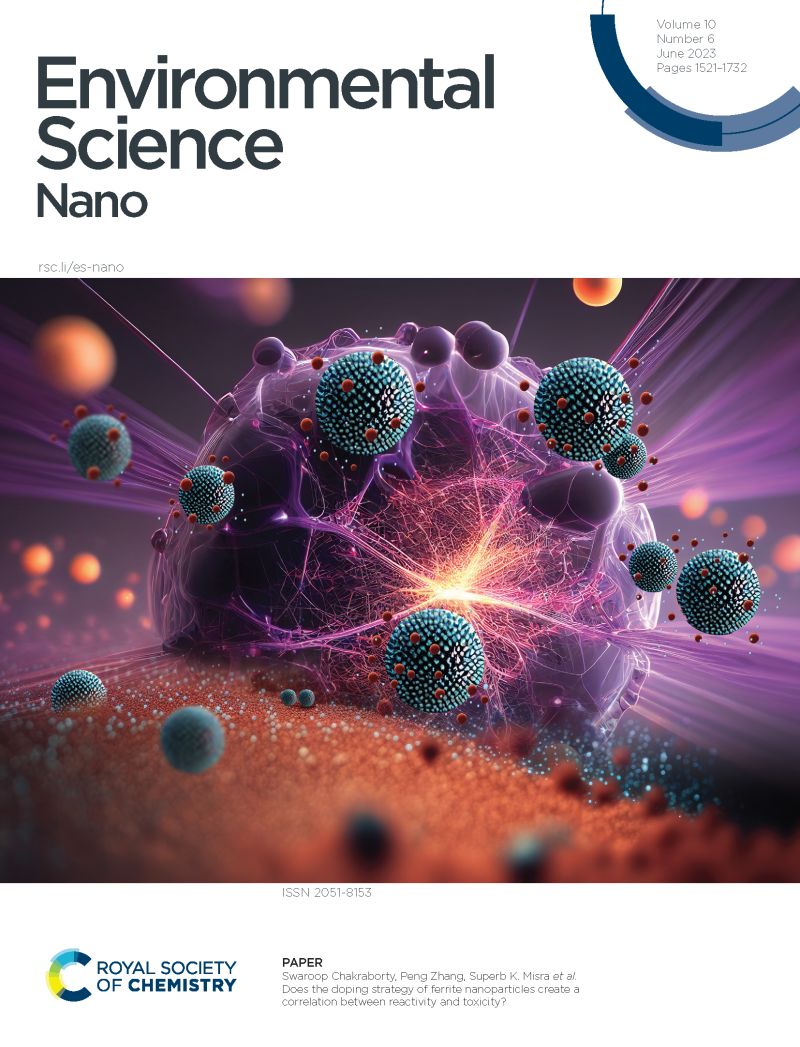Silver nanoparticles mitigated cadmium toxicity in tobacco by modulating biochemical, cellular and genetic responses
IF 5.8
2区 环境科学与生态学
Q1 CHEMISTRY, MULTIDISCIPLINARY
引用次数: 0
Abstract
Cadmium (Cd) contamination in soil poses hazardous impact on tobacco growth. The present study investigated the role of soil applied silver nanoparticles (Ag-NPs) to reduce Cd stress in tobacco by exploring morphological traits, photosynthetic efficiency, ROS (H2O2, O2·−) level, antioxidants as defense markers, cell death/viability, cellular and subcellular structural changes, and real-time qRT-PCR based gene expression analysis. The treatments comprised of a control (CK), 20 mg kg-1 cadmium stress (Cd), 50 µM amino silver nanoparticles (Ag-NPs) suspension, and combined cadmium and silver nanoparticles application (Cd + Ag-NPs). Results indicated that tobacco leaves recorded the maximum Cd content (144.53 µg g-1), followed by stem (70.96 µg g-1) and then root (50.15 µg g-1). The SEM and TEM analyses indicated Cd-induced stomatal injury and massive damage at subcellular level. Confocal microscopic visualization clarified the ROS accumulation and cell death by Cd-mediated redox imbalance. However, application of Ag-NPs effectively reduced Cd bioaccumulation (BCF) and root-to-shoot Cd translocation (TF) rate. Moreover, the Ag-NPs application (Cd + Ag-NPs) mitigated Cd-induced oxidative damage by improving the activities/levels of antioxidants such as APX, AsA, and SOD by 248.45%, 132.67% and 29.43%, respectively, compared with Cd only. The Ag-NPs also upregulated the expression of genes related to growth, chlorophyll, carotenoid biosynthesis, and antioxidative defense. Therefore, Ag-NPs can be employed as a sustainable approach to reduce environmental toxic impact of Cd and also to ensure food safety.银纳米粒子通过调节生物化学、细胞和遗传反应减轻烟草中的镉毒性
土壤镉(Cd)污染对烟草生长造成危害。本研究通过形态性状、光合效率、活性氧(H2O2、O2·−)水平、抗氧化剂防御标记、细胞死亡/活力、细胞和亚细胞结构变化以及基于实时qRT-PCR的基因表达分析,探讨了土壤施用银纳米粒子(Ag-NPs)对烟草Cd胁迫的影响。处理包括对照(CK)、20 mg kg-1镉胁迫(Cd)、50µM氨基银纳米颗粒(Ag-NPs)悬浮液和镉银纳米颗粒复合应用(Cd + Ag-NPs)。结果表明,烟叶Cd含量最高(144.53µg -1),茎次之(70.96µg -1),根次之(50.15µg -1)。扫描电镜和透射电镜分析显示cd诱导的气孔损伤和亚细胞水平的大量损伤。共聚焦显微镜显示了cd介导的氧化还原失衡导致的ROS积累和细胞死亡。Ag-NPs有效地降低了Cd的生物积累(BCF)和根尖间Cd转运(TF)速率。此外,与Cd相比,Ag-NPs (Cd + Ag-NPs)通过提高APX、AsA和SOD等抗氧化剂的活性/水平,分别提高了248.45%、132.67%和29.43%,减轻了Cd诱导的氧化损伤。Ag-NPs还上调了与生长、叶绿素、类胡萝卜素生物合成和抗氧化防御相关的基因的表达。因此,Ag-NPs可以作为一种可持续的方法来减少镉对环境的毒性影响,并确保食品安全。
本文章由计算机程序翻译,如有差异,请以英文原文为准。
求助全文
约1分钟内获得全文
求助全文
来源期刊

Environmental Science: Nano
CHEMISTRY, MULTIDISCIPLINARY-ENVIRONMENTAL SCIENCES
CiteScore
12.20
自引率
5.50%
发文量
290
审稿时长
2.1 months
期刊介绍:
Environmental Science: Nano serves as a comprehensive and high-impact peer-reviewed source of information on the design and demonstration of engineered nanomaterials for environment-based applications. It also covers the interactions between engineered, natural, and incidental nanomaterials with biological and environmental systems. This scope includes, but is not limited to, the following topic areas:
Novel nanomaterial-based applications for water, air, soil, food, and energy sustainability
Nanomaterial interactions with biological systems and nanotoxicology
Environmental fate, reactivity, and transformations of nanoscale materials
Nanoscale processes in the environment
Sustainable nanotechnology including rational nanomaterial design, life cycle assessment, risk/benefit analysis
 求助内容:
求助内容: 应助结果提醒方式:
应助结果提醒方式:


